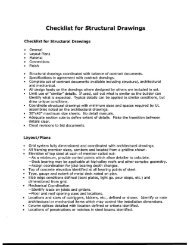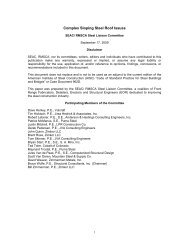Architecturally Exposed Structural Steel - Arquitectura en acero
Architecturally Exposed Structural Steel - Arquitectura en acero
Architecturally Exposed Structural Steel - Arquitectura en acero
Create successful ePaper yourself
Turn your PDF publications into a flip-book with our unique Google optimized e-Paper software.
A typical mill mark. The appearance of sheared edges that have be<strong>en</strong> ground.<br />
11. Grinding of sheared edges: Fabricator shall<br />
grind all edges of sheared, punched or flamecut<br />
steel to match approved mockup.<br />
12. Rolled Members: Member specified to be<br />
rolled to a final curved shape shall be fully<br />
shaped in the shop and tied during shipping to<br />
prev<strong>en</strong>t stress relieving. Distortion of the web<br />
or stem, and of outstanding flanges or legs of<br />
angles shall be visibly acceptable to the Architect<br />
from a distance of 20’ under any lighting<br />
condition determined by the Architect. Tolerances<br />
for the vertical and horizontal walls of<br />
rectangular HSS members after rolling shall be<br />
the specified dim<strong>en</strong>sion +/- ½”.<br />
13. Seal weld op<strong>en</strong> <strong>en</strong>ds of round and rectangular<br />
hollow structural section with 3 /8” closure<br />
plates. Provide continuous, sealed welds at<br />
angle to gusset-plate connections and similar<br />
locations where AESS is exposed to weather.<br />
2.1 SHOP CONNECTIONS<br />
A. Bolted Connections: Make in accordance with Section<br />
05120. Provide bolt type and finish as noted<br />
herein and align bolt heads as indicated on the approved<br />
shop erection drawings.<br />
B. Weld Connections: Comply with AWS D1.1 and<br />
Section 05120. Appearance and quality of welds<br />
shall be consist<strong>en</strong>t with the mock up. Assemble and<br />
10 AESS Supplem<strong>en</strong>t Modern <strong>Steel</strong> Constrution May 2003<br />
weld built-up sections by methods that will maintain<br />
alignm<strong>en</strong>t of members without warp exceeding<br />
the tolerance of this section.<br />
2.2 SHOP PRIMING<br />
A. Shop-prime steel surfaces, except the following:<br />
1. Surfaces embedded in concrete or mortar. Ext<strong>en</strong>d<br />
priming of partially embedded members<br />
to a depth of 2”.<br />
2. Surfaces to be field welded.<br />
3. Surfaces to be high-str<strong>en</strong>gth bolted with slipcritical<br />
connections, if primer does not meet<br />
the specified AISC slip coeffici<strong>en</strong>t.<br />
B. Surface Preparation: Clean surfaces to be painted.<br />
Remove loose rust, loose mill scale, and spatter,<br />
slag, or flux deposits. Prepare surfaces according to<br />
SSPC Specifications as follows:<br />
Editor’s Note: Surface preparation is the most important (and<br />
oft<strong>en</strong> the most costly) step in providing a good finish on AESS.<br />
A level of surface preparation is associated with each type of finish<br />
coat. It is critical that the correct level of preparation be specified<br />
on the contract docum<strong>en</strong>ts to avoid change orders during<br />
construction. Each level of SSPC specification includes the levels<br />
below (i.e., SSPC-6 includes the requirem<strong>en</strong>ts of SSPC-3).<br />
1. SSPC-SP 1 “Solv<strong>en</strong>t Cleaning”







